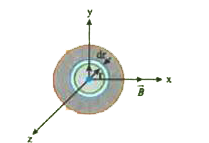A flat insulating disc of radius 'a' carries an excess charge on its surface is of surface charge density σC/m2. Consider disc to rotate around the perpendicular to its plane with angular speed ωrad/s/ If magnetic field →B is directed perpendicular to the roation axis, then find the torque acting on the disc.
Suppose the disc is placed in xy-plane and is rotated about the z-axis. Consider an annular ring of radius rand of thickness dr, the charge on this ring.
dq=σ(2πdr)
As the ring rotates with angular velocity ω , so the current i=dqdt=σ(2πrdr)2πω=σωrdr

The torque on the current loop →τ=i→A×→B
Hence the torque on this annular ring d→τ=i(d→A×→B)=σωrdr(πr2Bsin90∘)
=πσωr3Bdr and τ=πσωB∫ar3dr=πσωBa44
Topper's Solved these Questions
- MOVING CHARGES AND MAGNETISMBook:NARAYNAChapter:MOVING CHARGES AND MAGNETISMExercise:C.U.Q (AMPERE.S CIRCUITAL LAW MAGNETIC FIELD DUE TO STRAIGHT CONDUCTOR )
Explore 28 Videos
- MOVING CHARGES AND MAGNETISMBook:NARAYNAChapter:MOVING CHARGES AND MAGNETISMExercise:C.U.Q (TANGENT GALVANOMETER)
Explore 8 Videos
- MOVING CHARGES AND MAGNETISMBook:NARAYNAChapter:MOVING CHARGES AND MAGNETISMExercise:Level -II (H.W)
Explore 37 Videos
- MAGNETISM AND MATTERBook:NARAYNAChapter:MAGNETISM AND MATTERExercise:EXERCISE - 4 (SINGLE ANSWER TYPE QUESTION)
Explore 17 Videos
- NUCLEAR PHYSICSBook:NARAYNAChapter:NUCLEAR PHYSICSExercise:LEVEL-II-(H.W)
Explore 9 Videos
Similar Questions
A flat dielectric disc of radius R carries an exces charge on its surface. The surface charge density σ. The disc rotastes about an axis perpendicular to its lane passing thrugh the centre with angulasr velocity ω. Find the toruque on the disc if it is placed in a uniform magnetic field B directed perpendicular to the rotation axis.
View SolutionA flat disc of radius R charged uniformly on its surface at a surface charge density σ. About its central axis of rotation it rotates at an angular speed ω. Find the magnetic moment of disc due to rotation of charges.
View Solution
Knowledge Check
A long, hollow insulating cylinder of radius R and negligible thickness has a uniform surface charge density σ. The cylinder rotates about its central axis at a constant angular speed ω. Choose the correct option(s):
AThe charge crossing an imaginary line of length L on the surface of the cylinder, parallel to its axis, per unit time, is ωσRL.BThe magnetic moment of a length L of the cylinder is πωσR3LCThe magnetic field intensity at a point on the axis of the cylinder, inside the cylinder, is μ0ωσR2DIf the direction of rotation of the cylinder is reversed, the magnetic field at a point on the axis of the cylinder will also reverse direction
An infinite cylinder of radius r with surface charge density σ is rotated about its central axis with angular speed ω. Then the magnetic field at any point inside the cylinder is
View SolutionA circular wire of radius r rotates about its own axis with angular speed w in a magnetic field B perpendicular to its plane, then the induced e.m.f. is
View SolutionA uniform disc of radius R is charged with a uniform surface charge density σ. Find the electric potential due to the charges on the disc at a point on its edge. [σRπ∈0]
View SolutionA metal disc of radius R rotates with an angular velcoity ω about an axis perpendicular to its plane passing through its centre in a magnetic field B acting perpendicular to the plane of the disc. Calculate the induced emf between the rim and the axis of the disc.
View SolutionA disc of mass m, radius r and carrying charge q, is rotating with angular speed ω about an axis passing through its centre and perpendicular to its plane. Calculate its magnetic moment
View SolutionA copper disc of radius 1m is rotated about its natural axis with an angular velocity 2rad/sec in a uniform magnetic field 5 telsa with its plane perpendicular to the field. Find the emf induced between the centre of the disc and its rim.
View SolutionA non-conducting thin disc of radius R charged uniformly over one side with surface density σ, rotates about its axis with an angular velocity ω. Find (a) the magnetic field induction at the centre of the disc (b) the magnetic moment of the disc.
View Solution